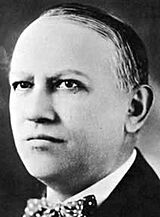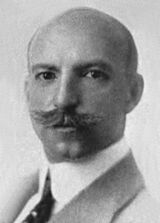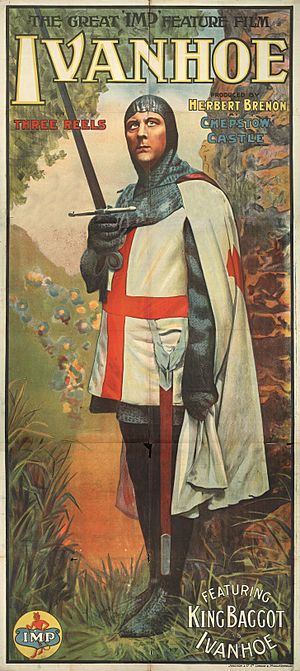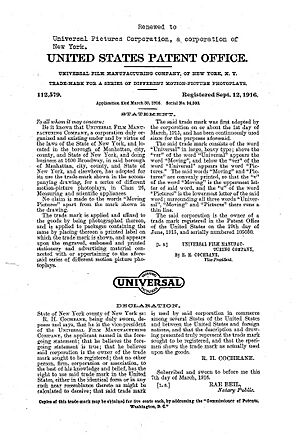Universal Pictures facts for kids
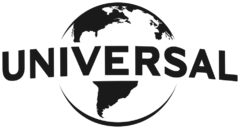
Logo used since 2013
|
|
|
Trade name
|
Universal Pictures |
|---|---|
|
Formerly
|
List
Universal Film Manufacturing Company (1912–1923)
Universal Pictures Corporation (1923–1936) Universal Productions, Inc. (1936–1937) Universal Pictures Company, Inc. (1937–1947) Universal-International (1946-1963) Universal City Studios, Inc. (1963–1996) |
| Division | |
| Industry | Film |
| Predecessor | Independent Moving Pictures |
| Founded | April 30, 1912 |
| Founders |
|
| Headquarters | 10 Universal City Plaza,
,
U.S.
|
|
Number of locations
|
3 |
|
Area served
|
Worldwide |
|
Key people
|
|
| Products | Motion pictures |
| Revenue | |
| Parent |
|
| Divisions |
|
| Subsidiaries |
|
Universal Pictures (also known as Universal Studios) is an American company that makes and shares movies all over the world. It is one of the oldest and most famous movie studios. Its headquarters is in Universal City, California, and it is part of NBCUniversal, which is owned by Comcast.
Universal was started in 1912 by a group of people including Carl Laemmle. This makes it the oldest movie studio still running in the United States. It is one of the "Big Five" major film studios in Hollywood.
Some of Universal's most popular movie series include Fast & Furious, Jurassic Park, and Despicable Me. The studio also created classic blockbusters like Jaws and E.T. the Extra-Terrestrial. When these films were first released, they became the highest-earning movies of all time. Universal Pictures is a member of the Motion Picture Association (MPA).
Contents
History
How Universal Got Started
Universal was founded by Carl Laemmle and his partners. Laemmle got into the movie business after watching a movie theater's ticket sales. He realized how much money movies could make and soon opened his own theaters, called nickelodeons.
At the time, the Motion Picture Patents Company, led by Thomas Edison, tried to control the movie industry. They charged fees for everything, from filming to showing movies. Laemmle and other theater owners didn't want to pay these fees, so they decided to make their own movies. In 1909, Laemmle started the Independent Moving Pictures Company (IMP).
Laemmle was one of the first to give actors credit in his films. This helped create the "star system," where actors became famous celebrities. He promoted stars like Florence Lawrence and King Baggot to attract audiences.
On April 30, 1912, the Universal Film Manufacturing Company was officially created. It was a merger of several smaller companies, with Laemmle as the president. The new company handled everything from making movies to distributing them to theaters.
Building Universal City
Like many in the film industry, Universal moved its operations west to the Hollywood area. On March 15, 1915, Carl Laemmle opened Universal City Studios. It was a huge production facility built on a 230-acre farm.
Unlike other studio bosses, Laemmle opened his studio to tourists, which was a new idea at the time. Universal became the biggest studio in Hollywood for about ten years. It mainly produced less expensive movies like westerns and melodramas for audiences in small towns.
In the 1920s, Universal created some of its most famous early films. These included The Hunchback of Notre Dame (1923) and The Phantom of the Opera (1925), both starring the popular actor Lon Chaney.
For a while, a young producer named Irving Thalberg helped improve the quality of Universal's films. However, he was hired away by another studio, and Universal went back to being a second-tier studio for many years.
Oswald the Lucky Rabbit
In 1927, Universal wanted to get back into making cartoons. They hired a producer named Charles Mintz, who brought them a new character called Oswald the Lucky Rabbit. Oswald was created by Walt Disney and Ub Iwerks.
The Oswald cartoons were a big hit. But when Mintz tried to pay Disney less money, Disney refused. Mintz then took most of Disney's animators to work for him. In response, Disney and Iwerks secretly created a new character: Mickey Mouse. Universal kept making Oswald cartoons with a new animation team led by Walter Lantz, who later created Woody Woodpecker.
In 2006, Universal's parent company sold the rights to the original Disney-made Oswald cartoons back to The Walt Disney Company.
The Golden Age of Universal Horror
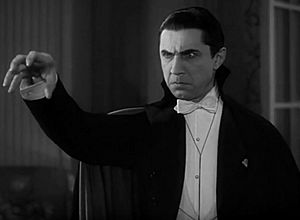
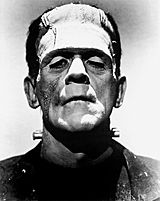
In 1928, Carl Laemmle made his son, Carl Laemmle Jr., the head of the studio. "Junior" wanted to make higher-quality films. He produced the Oscar-winning war movie All Quiet on the Western Front (1930).
Most famously, Laemmle Jr. started a series of horror films that became classics. These movies, known as Universal horror, included Dracula (1931), Frankenstein (1931), The Mummy (1932), and The Invisible Man (1933). These films made stars out of actors like Bela Lugosi and Boris Karloff.
However, making these bigger-budget movies was expensive. The Laemmle family had to borrow money for the first time to produce the musical Show Boat (1936). When they couldn't repay the loan, they lost control of the company they had founded.
New Owners and New Stars
After the Laemmles left, Universal focused on making less expensive films again. A producer named Joe Pasternak had great success with musicals starring a teenage singer named Deanna Durbin. Her first American film, Three Smart Girls (1936), was a huge hit and helped save the studio from financial trouble.
During the late 1930s and 1940s, Universal produced many popular film series. These included westerns, comedies, and sequels to their famous horror movies. The studio also found huge success with the comedy duo Abbott and Costello. Their movie Buck Privates (1941) was a massive hit.
Universal also began using Technicolor for big-budget films like Arabian Nights (1942) and a color remake of Phantom of the Opera (1943).
In 1946, the studio merged with International Pictures and was renamed Universal-International. The new leadership tried to make more "prestige" films, but many were not successful at the box office. The studio soon returned to making popular, low-budget movies like the Ma and Pa Kettle series.
The MCA Takeover and Modern Hits
In the late 1950s, the movie business was changing due to the rise of television. In 1958, the talent agency MCA bought the Universal studio lot. A few years later, in 1962, MCA took over the entire company.
With MCA in charge, Universal became a major A-list studio again. They signed famous directors like Alfred Hitchcock and produced many popular TV shows. In 1964, they launched the famous studio tour, which is still a popular attraction today.
During the 1970s, Universal released some of its biggest blockbusters ever. These included The Sting (1973), American Graffiti (1973), and the movie that changed Hollywood, Jaws (1975). In the 1980s and 1990s, the studio continued its success with hits like:
- E.T. the Extra-Terrestrial (1982)
- Back to the Future (1985)
- Jurassic Park (1993)
Universal in the 21st Century
Over the years, Universal has been owned by several different companies. In 1990, the Japanese electronics company Matsushita (now Panasonic) bought it. Later, it was sold to Seagram, and then to the French company Vivendi.
In 2004, Universal merged with NBC to become NBCUniversal, which was later bought by the cable company Comcast in 2011. Under Comcast, Universal has had some of its most successful years.
In 2015, Universal became the first studio to release three movies that each earned over $1 billion in a single year: Furious 7, Jurassic World, and Minions. The studio also acquired DreamWorks Animation in 2016, bringing franchises like Shrek and How to Train Your Dragon under its banner.
Today, Universal continues to be a leader in the film industry, producing everything from big-budget action movies and animated family films to horror movies from its partnership with Blumhouse Productions.
Famous Film Series
Universal is known for creating some of the longest-running and most successful film series in history.
- Universal Monsters: Starting in the 1930s, this series includes classics like Dracula, Frankenstein, and The Mummy.
- Jurassic Park: Beginning in 1993, this dinosaur franchise has grown to include multiple sequels and the Jurassic World trilogy.
- Fast & Furious: What started as a movie about street racing in 2001 has become a global action saga.
- Despicable Me: This animated series, which includes the popular Minions movies, is one of the highest-grossing animated franchises of all time.
- Bourne: A series of action-thriller films about a spy named Jason Bourne.
Highest-Grossing Films
Universal has produced many of the highest-grossing films ever made. In 2015, the studio had a record-breaking year with Furious 7, Jurassic World, and Minions.
|
|
‡ Includes money from re-releases in theaters.
Images for kids
Logos
-
Logo used from 1996 to 2012. The logo is still used on some properties, such as the independent company Universal Music Group
See also
 In Spanish: Universal Pictures para niños
In Spanish: Universal Pictures para niños


